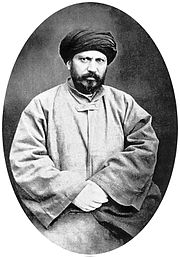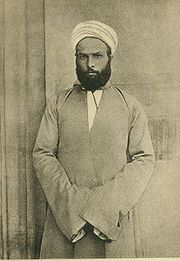- Al-Nahda
-
- Several Arab political parties and movements have been named "al-Nahda": For the Tunisian political party, see Ennahda Movement; for the Algerian political party, see Islamic Renaissance Movement.
- For the Omani football club, see Al-Nahda (Omani football club).
Al-Nahda (Arabic: النهضة / ALA-LC: an-Nahḍah; Arabic for "awakening" or "renaissance") was a cultural renaissance that began in the late 19th century and early 20th century in Egypt, then later moving to Ottoman-ruled Arabic-speaking regions including Lebanon, Syria and others. It is often regarded as a period of intellectual modernization and reform.
The Nahda is seen as connected to the cultural shock brought on by Napoleon's invasion of Egypt in 1798, and the reformist drive of subsequent rulers such as Muhammad Ali. The Egyptian nahda was articulated in purely Egyptian terms, and its participants were mostly Egyptians, and Cairo was undoubtedly the geographical center of the movement. But al-Nahda was also felt in neighboring Arab capitals, notably Beirut and Damascus. The shared language of Arabic-speaking nations ensured that the accomplishments of the movement could be quickly picked up by intellectuals in Arab countries.
In the Ottoman-ruled Arabic regions, major influence and motive were the 19th century tanzimat reforms of the Ottoman Empire, which brought a constitutional order to Ottoman politics and engendered a new political class, and later the Young Turk Revolution which allowed proliferation of press and other publications.[1]
Contents
Rifa'a Rafi' el-Tahtawi
Main article: Rifa'a el-Tahtawi Rifa'a el-Tahtawy, 1801-1873.
Rifa'a el-Tahtawy, 1801-1873.
The Egyptian scholar Rifa'a el-Tahtawi (1801–1873) is often seen as the pioneering figure of the Nahda. He was sent to Paris in 1826 by Muhammad Ali's government to study Western sciences and educational methods, although originally to serve as Imam for the Egyptian cadets training at the Paris military academy. He came to hold a very positive view of French society, although not without criticisms. Learning French, he began translating important scientific and cultural works into Arabic. He also witnessed the July Revolution of 1830, against Charles X, but, perhaps understandably, was careful in commenting on the matter in his reports to Muhammad Ali.[2] His political views, originally influenced by the conservative Islamic teachings at al-Azhar university, changed on a number of matters, and he came to advocate parliamentarism, women's education and, some hold, a degree of secularism.[3]
After five years in France, he then returned to Egypt to implement the philosophy of reform he had developed there, summarizing his views in the book Takhlis al-Ibriz fi Talkhis Bariz (sometimes translated as The Quintessence of Paris), published in 1834. It is written in rhymed prose, and describes France and Europe from an Egyptian Muslim viewpoint. Tahtawi's suggestion was that the Egypt and the Muslim world had much to learn from Europe, and generally embraced Western society, but also held that reforms should be adapted to the values of Islamic culture. This brand of self-confident but open-minded modernism came to be the defining creed of al-Nahda.
The influence of al-Nahda
Religion
In the religious field, Jamal al-Din al-Afghani (1839–1897) gave Islam a modernist reinterpretation and fused adherence to the faith with an anti-colonial doctrine that preached Pan-Islamic solidarity in the face of European pressures. He also favored the replacement of authoritarian monarchies with representative rule, and denounced what he perceived as the dogmatism, stagnation and corruption of the Islam of his age. He claimed that tradition (taqlid, تقليد) had stifled Islamic debate and repressed the correct practices of the faith. Al-Afghani's case for a redefinition of old interpretations of Islam, and his bold attacks on traditional religion, would become vastly influential with the fall of the Caliphate in 1924. This created a void in the religious doctrine and social structure of Islamic communities which had been only temporarily reinstated by Abdul Hamid II in an effort to bolster universal Muslim support, suddenly vanished. It forced Muslims to look for new interpretations of the faith, and to re-examine widely held dogma; exactly what al-Afghani had urged them to do decades earlier.
Al-Afghani influenced many, but greatest among his followers is undoubtedly his student Muhammad Abduh (1849–1905), whose teachings would play a similarly important role in the reform of the practice of Islam. Like al-Afghani, Abduh accused traditionalist Islamic authorities of moral and intellectual corruption, and of imposing a doctrinaire form of Islam on the umma, that had hindered correct applications of the faith. He therefore advocated that Muslims should return to the "true" Islam practiced by the ancient Caliphs, which he held had been both rational and divinely inspired. Applying the original message of the Prophet Muhammad with no interference of tradition or the faulty interpretations of his followers, would automatically create the just society ordained by God in the Qur'an, and so empower the Muslim world to stand against colonization and injustices.
Among the students of Abduh were Syrian Islamic scholar and reformer Rashid Rida (1865–1935), who continued his legacy, and expanded on the concept of just Islamic government. His theses on how an Islamic state should be organized remain influential among modern-day Islamists such as the Muslim Brotherhood.
Shia Islam
Shi'a scholars contributed to the renaissance movement, such as the linguist shaykh Ahmad Reda, the historian Muhammad Jaber al-Safa and Suleiman Daher, but, for obvious reasons, their influence on Sunni religious reform was rather limited. Important political reforms took place simultaneously also in Iran and Shi'a religious beliefs saw important developments with the systematization of a religious hierarchy. A wave of political reform followed, with the constitutional movement in Iran, to some extent paralleling the Egyptian Nahda reforms.
Literature
Further information: Egyptian literature and Arabic literatureThrough the 19th century and early 20th centuries, a number of new developments in Arabic literature started to emerge, initially sticking closely to the classical forms, but addressing modern themes and the challenges faced by the Arab world in the modern era.
In 1914, Muhammad Husayn Haykal (1888–1956) published Zaynab, the first Egyptian novel written in Egyptian Arabic. Prose writing rapidly developed from this date.
A group of young writers formed The New School, and in 1925 began publishing the a weekly literary journal al-Fajr (The Dawn), which would have a great impact on Arabic literature. The group was especially influenced by 19th-century Russian writers such as Dostoyevsky, Tolstoy and Gogol.
Monument to Shawqi in Villa Borghese, Rome
In poetry, the Egyptian Ahmad Shawqi, among others, began to explore the limits of the classical qasida, although he remained a clearly neo-classical poet. After him, others, including Hafez Ibrahim began to use poetry to explore themes of anticolonialism as well as the classical concepts. The Mahjar (emigrant) poets, of whom the most famous is the Lebanese Khalil Gibran (1883–1931), but which included other writers, in South America as well as the USA, further contributed to the development of the forms available to Arab poets.[4]
The Prophet, published in 1923 by the Boston-based Gibran, is perhaps the best known work of the era in the West, but was actually first written in English (Read The Prophet online here). Gibran's associate in the Arab-American League of the Pen (al-Rabita al-Qalamiyya), Mikha'il Na'ima (1898–1989) would later return to Lebanon and contribute to the development of the novel there.
One of the main literary innovators in the later stages of al-Nahda was Prof. Taha Hussein (1889–1973), the blind child of an Egyptian peasant family who is today widely considered an intellectual giant of Egypt, and apart from his Qur'anic education at al-Azhar held triple doctorates from Cairo University, the University of Sorbonne and the University of Paris. He served as Minister of Education in Egypt in the 1950s, and was responsible for creating free and mandatory schooling. His best known book is the autobiographical el-Ayyam (The Days).
Media
In 1821, Muhammad Ali of Egypt brought the first printing press to Egypt.[5] Modern printing techniques spread rapidly and gave birth to a modern Egyptian press, which brought the reformist trends of the al-Nahda into contact with the emerging Egyptian middle class of clerks and tradesmen. The Egyptian newspaper al-Ahram dates from 1875, and between 1870 and 1900, Beirut alone saw the founding of about 40 new periodicals and 15 newspapers.
- See also: List of Arabic newspapers
Language
The efforts at translating European and American literature led to the modernization of the Arabic language. Many scientific and academic terms, a well as words for modern inventions, were incorporated in modern Arabic vocabulary, and new words were coined in accordance with the Arabic root system to cover for others. The development of a modern press (see above) ensured that classical Arabic spread through society in its updated form, Modern Standard Arabic, which is used still today all over the Arab world. The Lebanese scholar Butrus al-Bustani (1819–83) created, in the late 19th century, the first modern Arabic encyclopedia, drawing both on medieval Arab scholars and Western methods of lexicography, and Ahmad Reda created the first modern dictionary of Arabic, "Matn al-Lugha" ("Lisan al-Arab" was written in the 13th century).
Politics
In 1876, the Ottoman Empire promulgated a constitution, as the crowning accomplishment of the tanzimat reforms (1839–76) and inaugurating the Empire's First Constitutional Era. It was inspired by European methods of government and designed to bring the Empire back on level with the Western powers. The constitution was opposed by the Sultan, whose powers it checked, but had vast symbolic and political importance.
The introduction of parliamentarism also created a political class in the Ottoman-controlled provinces, from which later emerged a liberal nationalist elite that would spearhead the several nationalist movements, in particular Egyptian nationalism. Egyptian nationalism was non-Arab, emphasising ethnic Egyptian identity and history in response to European colonialism and the Turkish occupation of Egypt. This was paralleled by the rise of the Young Turks in the central Ottoman provinces and administration. The resentment towards Turkish rule fused with protests against the Sultan's autocracy, and the largely secular concepts of Arab nationalism rose as a cultural response to the Ottoman Caliphates claims of religious legitimacy. Various Arab nationalist secret societies rose in the years prior to World War One, such as al-Fatat and the military based al-Ahd.
This was complemented by the rise of other national movements, including Syrian nationalism, which like Egyptian nationalism was in some of its manifestations essentially non-Arabist and connected to the concept of Greater Syria. The main other example of the late al-Nahda era is the emerging Palestinian nationalism, which was set apart from Syrian nationalism by Zionist immigration to Palestine and the resulting sense of Palestinian particularism.
References
- ^ Adnan A. Musallam, Arab Press, Society and Politics at the End of The Ottoman Era
- ^ Peter Gran, "Tahtawi in Paris," Al-Ahram Weekly Online, Issue No.568, 10–16 January 2002.
- ^ Barbara Winckler, "Rifa'a Rafi' al-Tahtawi: France as a Role Model," Qantara, 7/21/2005.
- ^ See Somekh, "The Neo-Classical Poets" in M.M. Badawi (ed.) "Modern Arabic Literature", Cambridge University Press 1992, pp36-82
- ^ Sabri Al-Adl, "All the Pasha's Papers," Al-Ahram Weekly Online, Issue No. 742, 12–18 May 2005.
Further reading
- Hourani, Albert, A History of the Arab Peoples, New York: Warner Books, 1991. (ISBN 0-446-39392-4)
- Lapidus, Ira M., A History of Islamic Societies, 2nd Ed. Cambridge University Press
- Armstrong, Karen The Battle for God, 2000
- Kassir, Samir Considérations sur le malheur arabe, Paris, 2004.
External links
- Plain talk - by Mursi Saad ed-Din, in al-Ahram Weekly.
- Tahtawi in Paris - by Peter Gran, in al-Ahram Weekly.
- France as a Role Model - by Barbara Winckler
Categories:- Al-Nahda
- Egyptian culture
- Arabic words and phrases
- Islamic culture
- Islamic politics and Islamic world studies
Wikimedia Foundation. 2010.



